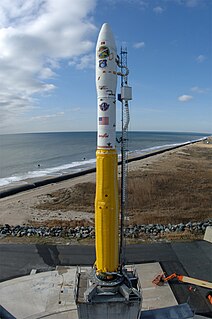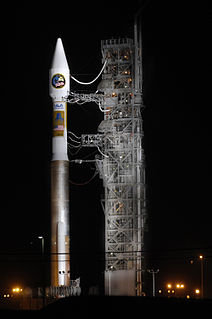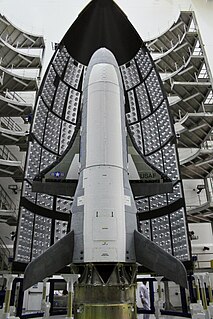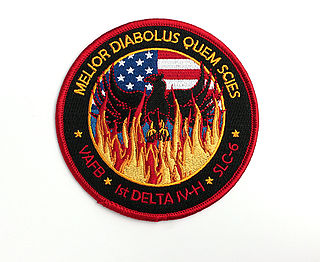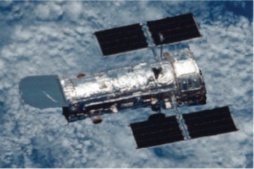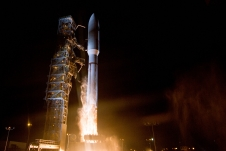| Mission type | SIGINT |
|---|---|
| Operator | US NRO |
| COSPAR ID | 2011-014A |
| SATCAT no. | 37386 |
| Spacecraft properties | |
| Bus | NOSS-3 or NOSS-4 |
| Start of mission | |
| Launch date | 04:24,April 15, 2011(UTC) |
| Rocket | Atlas V 411 AV-027 |
| Launch site | Vandenberg SLC-3E |
| Orbital parameters | |
| Reference system | Geocentric |
| Regime | Low Earth |
| Perigee | 1,017 km |
| Apogee | 1,204 km |
| Inclination | 63.45° [1] |
| Epoch | April 2011 |
USA-229, known before launch as NRO Launch 34 (NROL-34), is a pair of American signals intelligence satellites which were launched in 2011. They are operated by the United States National Reconnaissance Office.

The United States of America (USA), commonly known as the United States or America, is a country composed of 50 states, a federal district, five major self-governing territories, and various possessions. At 3.8 million square miles, the United States is the world's third or fourth largest country by total area and is slightly smaller than the entire continent of Europe's 3.9 million square miles. With a population of over 327 million people, the U.S. is the third most populous country. The capital is Washington, D.C., and the largest city by population is New York City. Forty-eight states and the capital's federal district are contiguous in North America between Canada and Mexico. The State of Alaska is in the northwest corner of North America, bordered by Canada to the east and across the Bering Strait from Russia to the west. The State of Hawaii is an archipelago in the mid-Pacific Ocean. The U.S. territories are scattered about the Pacific Ocean and the Caribbean Sea, stretching across nine official time zones. The extremely diverse geography, climate, and wildlife of the United States make it one of the world's 17 megadiverse countries.

Signals intelligence (SIGINT) is intelligence-gathering by interception of signals, whether communications between people or from electronic signals not directly used in communication. Signals intelligence is a subset of intelligence collection management.

In the context of spaceflight, a satellite is an artificial object which has been intentionally placed into orbit. Such objects are sometimes called artificial satellites to distinguish them from natural satellites such as Earth's Moon.
Both satellites were deployed by a United Launch Alliance Atlas V 411 carrier rocket, which launched from Space Launch Complex 3E at the Vandenberg Air Force Base. The launch occurred at 04:24 UTC on 15 April 2011. [2] The rocket placed the satellites into a low Earth orbit. By 04:29 UTC, official updates on the status of the spacecraft had been discontinued. [3]

United Launch Alliance (ULA) is a provider of spacecraft launch services to the United States government. It was formed as a joint venture between Lockheed Martin Space Systems and Boeing Defense, Space & Security in December 2006 by combining the teams at the two companies. U.S. government launch customers include the Department of Defense and NASA, as well as other organizations. With ULA, Lockheed and Boeing held a monopoly on military launches for more than a decade until the US Air Force awarded a GPS satellite contract to SpaceX in 2016.

Atlas V is an expendable launch system in the Atlas rocket family. It was formerly operated by Lockheed Martin and is now operated by United Launch Alliance (ULA), a joint venture with Boeing. Each Atlas V rocket uses a Russian-built RD-180 engine burning kerosene and liquid oxygen to power its first stage and an American-built RL10 engine burning liquid hydrogen and liquid oxygen to power its Centaur upper stage. The RD-180 engines are provided by RD Amross, while Aerojet Rocketdyne provides both the RL10 engines and the strap-on boosters used in some configurations. The standard payload fairing sizes are 4 or 5 meters in diameter and of various lengths. Fairings sizes as large as 7.2 m in diameter and up to 32.3 m in length have been considered. The rocket is assembled in Decatur, Alabama and Harlingen, Texas.

Space Launch Complex 3 (SLC-3) is a launch site at Vandenberg Air Force Base that has been used by Atlas and Thor rockets. It was built in the early 1960s and consists of two pads, SLC-3E (East) and SLC-3W (West). The East-West coastline at Vandenberg allows SLC-3 to launch over-ocean polar trajectories that avoid landfall until passing over Antarctica. By contrast, Cape Canaveral has a North-South coastline permitting over-ocean launches into standard orbits.
Whilst details of the satellites and their missions are officially classified, amateur observers have identified that the Atlas V deployed two satellites, one of which has officially been catalogued as debris. The two spacecraft have been identified as being a pair of third or fourth generation Naval Ocean Surveillance System satellites. [4] Amateur observations have located the spacecraft in an orbit with a perigee of 1,025 kilometres (637 mi) and an apogee of 1,207 kilometres (750 mi), inclined at 64.4 degrees to the plane of the equator. [2] Current generation NOSS satellites are always launched and operated in pairs, [5] and are used to locate and track ships from the radio transmissions that they emit. [6]

The Naval Ocean Surveillance System (NOSS) is a series of signals intelligence satellites that have conducted electronic signals intelligence for the U.S. Navy since the early 1970s. The first series of satellites were codenamed "White Cloud" or "PARCAE", while second and third-generation satellites have used the codenames "Ranger" and "Intruder".
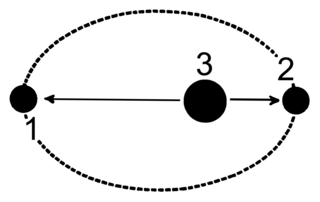
The term apsis refers to an extreme point in the orbit of an object. It denotes either the points on the orbit, or the respective distance of the bodies. The word comes via Latin from Greek, there denoting a whole orbit, and is cognate with apse. Except for the theoretical possibility of one common circular orbit for two bodies of equal mass at diametral positions, there are two apsides for any elliptic orbit, named with the prefixes peri- and ap-/apo- added to a reference to the body being orbited. All periodic orbits are, according to Newton's Laws of motion, ellipses: either the two individual ellipses of both bodies, with the center of mass of this two-body system at the one common focus of the ellipses, or the orbital ellipses, with one body taken as fixed at one focus, and the other body orbiting this focus. All these ellipses share a straight line, the line of apsides, that contains their major axes, the foci, and the vertices, and thus also the periapsis and the apoapsis. The major axis of the orbital ellipse is the distance of the apsides, when taken as points on the orbit, or their sum, when taken as distances.
